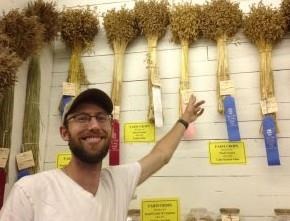By Maria M. Lameiras
For most row crop producers in Georgia, corn, cotton and peanut are planted in the spring and harvested in late fall. After harvest, the ground is left relatively bare, with the residue of the harvested crop the only organic material left on the ground. That is when cover crops come in.
Cover crops are non-crop plants like crimson clover and rye that are planted after cash crops are harvested in the fall. They are left to grow until producers prepare for spring planting, at which point cover crops are terminated. Cover crops provide living roots in the ground over the winter, and a mat of residue on the soil surface prior to cash crop planting. Over the last few decades, researchers have found that cover crops improve various soil properties and contribute positively to weed management.


Examples of a living mulch (top) and cereal rye cover crop terminated prior to planting (bottom).
Now, UGA weed scientist Nicholas Basinger and doctoral candidate David Weisberger, researchers in the University of Georgia’s College of Agricultural and Environmental Sciences, are studying the use of both annual and perennial cover crops called “living mulches” in cotton. Weisberger developed a program to test the use of living mulches and annual cover crops in cotton production in Georgia based on previous work using living mulches in corn production performed by UGA Professor Emeritus Nick Hill.
“It seemed like a natural extension of the work to try this with one of the state’s most economically relevant row crops,” said Weisberger, who received funding for the three-year project from Cotton Incorporated. “Cover cropping and even the use of living mulches is not that new, but it is something that's fairly new to cotton production.”
Under the surface
In fall 2019, Weisberger, Basinger and a team of soil scientists from the Department of Crop and Soil Sciences including soil pedologist Matthew Levi, doctoral student Chandler Greuner, and soil physicist Nandita Gaur established a study at the J. Phil Campbell Sr. Research and Education Center in Watkinsville, Georgia. Research plots were planted with a bare ground control, two annual cover crops — cereal rye and crimson clover — and a living mulch. The living mulch is a white clover (cultivar 'Durana') that was originally developed by UGA as a forage for cattle.
“Being able to do studies like this, bringing in other students and faculty from our department to get a really full picture both from above and below ground, can help drive a better understanding of what’s actually happening in the system and what the true benefits and drawbacks of each system are," Basinger said. “That helps us have more understanding about where we would prescribe this and where it will best fit.”
The goal of the study is to quantify both aboveground and belowground effects of these annual cover crops and a living mulch compared to a standard no-till bare ground system. The researchers are measuring cotton yield and weed suppression as well as changes in the soil's physical and chemical properties. Weisberger and Basinger are focused on how these cover crops may help to manage Palmer amaranth, a costly and problematic weed.
“The goal has been to incorporate more cover crops so that there's a blanket on the soil that suppresses those little Palmer amaranth seeds that are down in the ground and keeps them from waking up,” Weisberger said. In the weed-control studies, researchers are calculating how well the cover crop or living mulch suppresses weed emergence, survival and adult seed production in cotton plots pre-seeded with this problematic species. “The idea was to start at the same level of infestation and to look at how those different covers, or lack thereof, affect the weed population over time,” Weisberger said.
 Led by doctoral candidate David Weisberger, UGA researchers are quantifying both aboveground and belowground effects of annual cover crops and a living mulch compared to a standard no-till bare ground system.
Led by doctoral candidate David Weisberger, UGA researchers are quantifying both aboveground and belowground effects of annual cover crops and a living mulch compared to a standard no-till bare ground system.Gruener and Levi will also study the soil health benefits of both the living mulch and annual cover crop study plots. They will measure changes to soil physical properties that affect water movement and storage, in addition to changes in organic matter, particularly nitrogen and carbon.
Getting out of the weeds
According to Basinger, it is important to balance long-term and short-term goals with a study like this.
“So many of these properties, especially from the soil perspective, are slow to change, so that's one of the big challenges we have. Soil properties tend to change much more slowly, but from a weed perspective we can determine some important findings each year,” Basinger explained.
The initial findings are promising. In the first year of the study, both the cover crop and living mulch plots showed a major reduction in the number of Palmer amaranth weeds that emerged. This is particularly important for a weed like Palmer amaranth that has developed resistance to seven herbicide sites of action globally, including resistance to herbicides like Roundup and Atrazine. One important way to lessen the selection pressure of herbicides on this weed is to reduce the number that germinate and are exposed to those herbicides.
The living mulch system may have additional benefits related to both economics and the environment. Because crops are planted into 10- to 12-inch strips in the living mulch system, herbicides are only used in this strip area.
 “We're seeing a lot of benefits from (the living mulch system) just from a weed suppression standpoint," said assistant professor Nicholas Basinger.
“We're seeing a lot of benefits from (the living mulch system) just from a weed suppression standpoint," said assistant professor Nicholas Basinger.“By covering the ground with our living mulch and just treating those strips, you reduce your herbicide input by approximately 70%,” Weisberger said. Additionally, based on Hill’s previous research with living mulches in corn, this species of white clover has also been shown to provide 50 to 60 pounds per acre of nitrogen. This may help eliminate or greatly reduce the need to purchase synthetic nitrogen fertilizer.
Using a living mulch system is not without its tradeoffs, however. Living mulches may reduce yields given that, unlike terminated annual cover crops, they require nutrients and water throughout the season. Fields planted with living mulches also require irrigation, removing them as an option for dryland production systems.
Cost-benefit analysis
“This living mulch system isn't necessarily going to be perfect for every farmer in Georgia or the Southeast, but it does fit a niche and there is a group of growers who are interested in sustainability and who have the irrigation resources they need to try it,” Basinger said. “We're seeing a lot of benefits from it just from a weed suppression standpoint. The focus of our lab is integrated with management and our job is to find all the tools that are in the toolbox and be able to look at those and see what combination of tools we can utilize to give us a really resilient system.”
Because farming systems and environments vary so greatly in Georgia, the researchers made sure to include two different annual cover crops in the study. For example, cereal rye has been used widely in Georgia as an annual cover crop because of cold tolerance and the ability to grow it in many soil conditions, as well as having deep roots and rapid accumulation of biomass.
“We have really variable environments in Georgia — from very sandy soils further south closer to the Florida line that don’t have a lot of water- or nutrient-holding capacity to the heavy clay soils that we have in north Georgia. We have a diversity of growers trying to grow cotton across the state and we need to figure out what works best for each of the areas so that our constituents know which systems are going to be best for south Georgia growers and which are going to be best for growers in north Georgia.”
Source : uga.edu